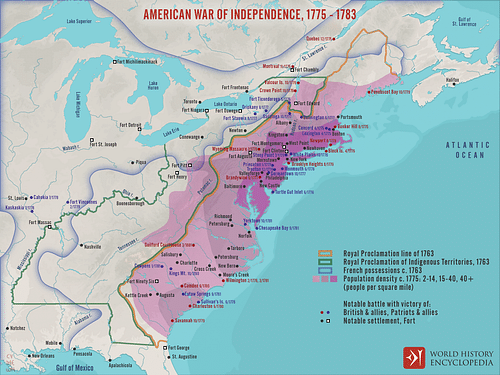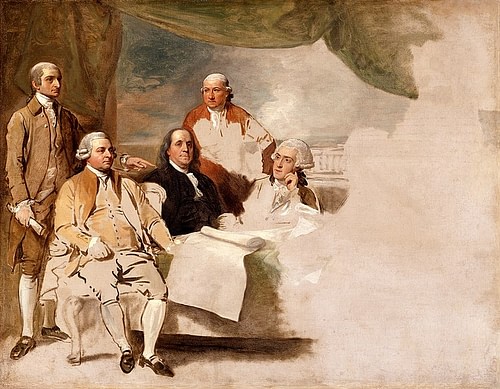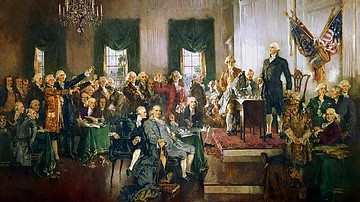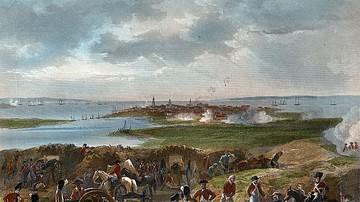
Henry Laurens (1724-1792) was an American statesman from South Carolina who played an important role in the politics of the American Revolution (1765-1789). He served as president of the Second Continental Congress from 1777-78 and presided over the passage of the Articles of Confederation. He also served as a peace commissioner for the Treaty of Paris of 1783.
Early Life
Henry Laurens was born in Charleston, South Carolina, on 6 March 1724. His family, of French Huguenot origin, had initially settled in Charleston in 1715 and had, since that time, become very wealthy; Henry's father, John, ran the largest saddle business in the Thirteen Colonies. The third child and eldest son of John and Hester Laurens, Henry was sent to London in 1744 to learn a trade, becoming apprenticed to a successful English merchant. He remained in England for three years, until the death of his father in 1747 precipitated his return to South Carolina. Only 23 years old, Henry Laurens inherited his father's estate and large fortune, giving him the capital to launch a business of his own.
By this point, Charleston was one of only four towns in British North America that could, in any sense of the word, be rightfully referred to as a 'city'; the others were Boston, New York, and Philadelphia. Its port was one of the busiest in the colonies and was currently experiencing a booming rice trade; merchants would export South Carolina rice to Cape Finisterre, Spain, in return for various other commodities. Laurens was eager to hop on this bandwagon and, in 1748, teamed up with another Charleston merchant named George Austin to create an import-export firm, called Austin & Laurens. The firm started out exporting rice in exchange for rum and British luxury items, and the business soon proved quite profitable.
With his business flourishing, Laurens next turned his attention to finding a wife and starting a family. He courted Eleanor Ball, the daughter of a wealthy South Carolinian rice planter, whom he married on 25 July 1750. The couple would, ultimately, have twelve children, although only four survived to adulthood: John Laurens (b. 1754), Martha "Patsy" Laurens (b. 1759), Henry "Harry" Laurens, Jr., (b. 1763), and Mary Eleanor "Polly" Laurens (b. 1770).
Slave Trade
By the time of Laurens' marriage in 1750, his firm had become internationally recognized for its diligence and integrity regarding its business dealings. This reputation led more business to come Laurens' way, and his firm was soon trading with merchants in London, Rotterdam, Lisbon, Madrid, and the West Indies. As the firm became bigger, it soon began dealing in more lucrative commodities – including the human cargo of the West African slave trade. Laurens had made contacts with Grant, Oswald & Company, a business that controlled a slave outpost in Sierra Leone, and began exchanging rice for enslaved Africans. Laurens' firm was also responsible for receiving, marketing, and auctioning off the slaves in Charleston. This made Laurens immensely rich, as the slave trade paid out a 10% commission, compared to the 5% commission that was typical in the trade of most other commodities. The firm Austin & Laurens ultimately handled the sale of over 8,000 people, turning Henry Laurens into one of the wealthiest men in all North America by the time of the revolution.
Laurens was not only a participant in the slave trade but was a slaveowner as well. By the mid-1760s he owned about 300 people, who were condemned to toil on his main residence of Mepkin Plantation (located about 40 miles/64 km upriver from Charleston) or on his smaller properties. Laurens was, as author Gabriel Neville points out, "a loving husband and father and a joyfully committed Christian," who was, in his business dealings, "punctual, diligent, and fair" (Neville, 2019). But, at least initially, these qualities did not seem to give Laurens any moral qualms about making a living off the sale and perpetual bondage of human beings. In 1755, he wrote a letter to another businessman in which he matter-of-factly explained what South Carolinian planters looked for in a slave:
Very healthy people, two thirds at least men from 18-25 years old, the other young women from 14-18, the cost not to exceed twenty-five Pounds Sterling per head…Gold Coast and Gambias are best, next to them Winward Coast are preferred to Angolas. We would not choose them sent in the Hurricane Season but rather to come in the months of October or November. Pray observe that our people like tall Slaves best for our business and strong withal (NPS.gov).
But as time went on, Laurens' views on slavery changed. Perhaps his moral conscience was slowly gnawing away at him for, in 1769, he abruptly left the slave trade. While he initially claimed his retirement was due to practical considerations, he later stated that his moral quandaries had become too large to ignore; it was a Bible passage, he claimed, that had changed his mind. But whether or not Laurens truly exited the slave trade for ethical reasons, he failed to emancipate his own slaves. Perhaps he was terrified that at least one of his 300 enslaved persons would seek revenge for their years of forced servitude, or perhaps his supposed moral quandaries were not enough to convince him to lower his status and financial situation by releasing his enslaved workers. As Neville notes, it was a dilemma that concerned many other contemporary slaveowners, such as Thomas Jefferson and George Washington, both of whom came to detest the institution of slavery on ethical grounds but were too afraid to let their own slaves go in their lifetimes.

Colonial Politics
In 1757, Laurens joined the South Carolina militia as a lieutenant colonel. The Thirteen Colonies were, at the time, embroiled in the French and Indian War (1754-1763) which, in turn, brought the colonies into conflict with the Cherokee nation; between 1757 and 1761, Laurens participated in multiple military campaigns against the Cherokee, with his business contributing £7,000 to the war effort. In 1757, Laurens was also elected to the South Carolina colonial assembly and served on the body continually for the next 18 years.
The firm Austin & Laurens broke apart in 1762 when George Austin moved to England, but Laurens continued participating in trade as a solo practitioner until his retirement in 1769. In 1762, Laurens purchased Mepkin Plantation, a 3,000-acre (1,214 ha) farm on which he grew corn, indigo, and wheat, which were cultivated by his enslaved workers and indentured servants. As he began to move away from the mercantile business in the mid-1760s, Laurens bought more plantations in South Carolina and Georgia to increase his rice and indigo production; by the end of the decade, he owned over 20,000 (8,094 ha) acres of land.
In 1765, hoping to pay off the debts incurred during the French and Indian War, the British Parliament imposed the Stamp Act on the colonies; this required colonists to pay a tax on all paper documents, from legal contracts to calendars to playing cards. This caused mass outrage amongst the colonists, many of whom believed that Parliament was violating their constitutional rights by taxing them without their consent. Although Laurens personally opposed the Stamp Act, he urged a peaceful solution, supporting a boycott of British imports until the tax was repealed. Other colonists were not so willing to wait; led by an underground group of political agitators known as the Sons of Liberty, mobs of enraged South Carolinians took to the streets of Charleston, hanging effigies of stamp collectors and storming houses in search of the hated stamps. At midnight on 25 October 1765, a mob of drunken rioters broke into Laurens' home, believing that he was hiding the stamps on behalf of the royal governor. The confrontation lasted for over an hour before the rioters went home. Although the break-in traumatized Laurens' wife, the rioters did not break or steal anything once they were inside the house.
Although Laurens continued to speak out against the Townshend Acts (1767-68), he continued to believe that reconciliation with Britain was still possible. But all thoughts of politics were put aside when, in the spring of 1770, Eleanor Ball Laurens died while giving birth to their youngest daughter, Polly. Laurens, beset with grief, needed to be alone and sent his sons to England to finish their educations, while his daughters went to live with his brother James in Charleston.
Revolutionary Activity
By 1774, Laurens had resumed his activity in American politics. The Boston Massacre (1770) and the passage of the so-called Intolerable Acts (1774) had alienated him from Britain and had caused his politics to align more closely with the Patriots. In early 1775, South Carolina followed the example of Massachusetts and created a revolutionary government known as the Provincial Congress; Laurens was elected to that body and, for a time, served as its president. Once the outbreak of the American Revolutionary War in April 1775 further eroded hopes of reconciliation with the British Crown, Laurens worked with nine other delegates on a temporary constitution for South Carolina. On 26 March 1776, South Carolina became the second colony to adopt a constitution.

On 28 June 1776, the war came to Laurens' doorstep, when a British expeditionary force under General Henry Clinton attempted to seize control of Charleston. The British were defeated by a Patriot force under Colonel William Moultrie at the Battle of Sullivan's Island, forcing Clinton to sail back to New York Harbor. Only a week later, the United States of America declared its independence. Charleston celebrated with a reading of the Declaration of Independence beneath the city's Liberty Tree; but, as Neville notes in his article, the speaker was shaded by a parasol held by a slave. Similar sights caused the issue of slavery to weigh heavily on Laurens' mind while the rest of Charleston celebrated independence. Shortly afterward, he wrote to his son John:
You know, my dear son, I abhor slavery. I was born in a country where slavery had been established by British kings and parliaments, as well as by the laws of the country ages before my existence. I found the Christian religion and slavery growing under the same authority and cultivation. I nevertheless disliked it…I am not the man who enslaved them; they are indebted to the English for that favor; nevertheless, I am devising means for manumitting many of them, and for cutting off the entail of slavery. Great powers oppose me – the laws and customs of my country, my own and the avarice of my countrymen. (NPS.gov)
Laurens' belief that the British were the main cause for slavery, though hypocritical, may have helped him decide to accept election to the Second Continental Congress in January 1777. He did not have much time to learn the ropes, however; when the Congress' first president, John Hancock, resigned in November, Laurens was chosen to replace him. In his capacity as congressional president, Laurens oversaw the adoption of the Articles of Confederation, the United States' initial constitution that established a weak central government to safeguard the sovereignty of the states; the states, however, did not finish ratifying the Articles until 1781. Laurens also used his influence as president to secure a position for his 23-year-old son John on the staff of General George Washington. Colonel John Laurens eventually served as an aide-de-camp to Washington and became close friends with Alexander Hamilton.
John Laurens was a staunch abolitionist who, unlike his father, was quite vocal about his beliefs. While the Continental Army was at Valley Forge in the winter of 1777-78, John wrote to his father about the possibility of enlisting enslaved men into the Continental Army in exchange for emancipation. Henry had initially disapproved of John's plan – he still feared a slave revolt and was reluctant to willingly arm slaves – but once the American South became threatened by the British in 1779, Henry Laurens changed his mind. In March 1779, he helped push through a resolution allowing the recruitment of Black soldiers (only formalizing a practice that had, in reality, already been going on for years). This was as far as Henry Laurens was willing to go, as he declined all of his son's entreaties to free the family slaves.
As the president of the Congress, Laurens could not avoid getting sucked into the factionalism that plagued the assembly. His close association with the radical Adams-Lee faction, and his role in exposing the so-called Conway Cabal that had conspired to replace Washington as head of the Continental Army, earned him powerful enemies. One of these enemies was Silas Deane of Connecticut, one of the commissioners that Congress had sent to Europe to secure foreign aid. After being accused of corruption, Deane was recalled, causing him and his allies to lash out against the members of the Adams-Lee faction, which included Laurens. Laurens, who was already battling a nasty gout affliction, found that he did not have the energy for such partisanship and resigned from the presidency in December 1778. He nevertheless agreed to remain in Congress until the Articles of Confederation were ratified by the states.
Imprisonment in the Tower of London
In October 1779, Laurens was chosen to travel to The Hague and negotiate a treaty of commerce with the Dutch Republic, with specific instructions to negotiate a loan of ten million dollars. Although his departure was delayed by the war, he finally set sail from Philadelphia on 13 August 1780 aboard the ship Mercury. The vessel was off the coast of Newfoundland when, on 3 September, it was captured by a British warship. Laurens hurriedly threw his official papers overboard, but they were retrieved by the British; Great Britain would use these captured documents as a pretext to declare war on Holland.
Laurens was hauled to London as a prisoner, where he was questioned by police authorities and even by the king's Privy Council. On 6 October 1780, he was imprisoned in the Tower of London "on suspicion of high treason" (Boatner, 600). He was confined there for 15 months, kept in conditions that negatively impacted his already declining health; however, he nevertheless refused two offers of release in exchange for providing service to the British. In April 1781, John Laurens arrived in Paris to serve as an envoy to King Louis XVI of France, and immediately petitioned the French government to help secure his father's release; the British government was also pressured by notable figures like Benjamin Franklin and British politician Edmund Burke to release Laurens. After several months of negotiations, it was determined that Henry Laurens could be released in exchange for a high-ranking British prisoner. On 31 December 1781, Laurens was exchanged for Lord Charles Cornwallis, who had been captured after his defeat in the Siege of Yorktown. Laurens was the only American to ever be imprisoned in the Tower of London.
Later Career & Death
In November 1782, Henry Laurens was selected by Congress to go to Paris as one of the peace commissioners, alongside Ben Franklin, John Adams, and John Jay. He participated in the negotiations but, since he was not an official minister, did not sign the Treaty of Paris of 1783, which finally ended the US War of Independence. While he was in Europe, Laurens received devastating news. His eldest son, Colonel John Laurens, had been killed in a skirmish with the British on 27 August 1782, one of the last Americans to die in the Revolutionary War. Distraught, Laurens remained in Europe, acting as an unofficial US minister to the British, with whom he consulted on commercial matters.

Laurens returned to New York City in August 1784, where he reported his mission to Congress. He declined offers to return to Congress; he had lost an estimated £40,000 in property damages during the war, and his health was in decline ever since imprisonment, leaving him with no desire to resume public life. He returned to Mepkin Plantation, where he entered into semi-retirement. He continued to speak privately against slavery, writing to Alexander Hamilton in 1785 that he was trying to convince his fellow citizens to give up the slave trade, although his "attempts have hitherto been fruitless" (Neville, 2019). His ill health and preoccupation with repairing his damaged properties prevented him from pursuing the matter in the political sphere.
In 1787, Laurens declined offers to attend the US Constitutional Convention as a delegate but did serve on the assembly that ratified the US Constitution for South Carolina in 1788. In 1789, he served as a presidential elector for South Carolina and cast his state's vote for George Washington as the first president of the United States. This was to be his last act of public service. On 8 December 1792, Henry Laurens died at Mepkin Plantation, at the age of 68. In his will, he stipulated his preference for cremation over burial, owing to his lifelong fear of being buried alive; Laurens was, therefore, the first high-profile American to be cremated.








